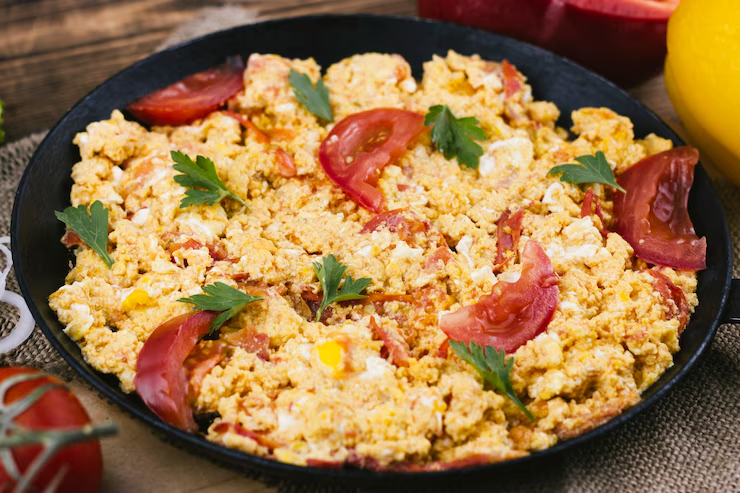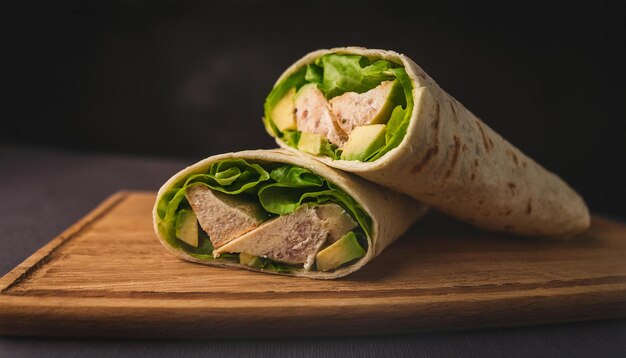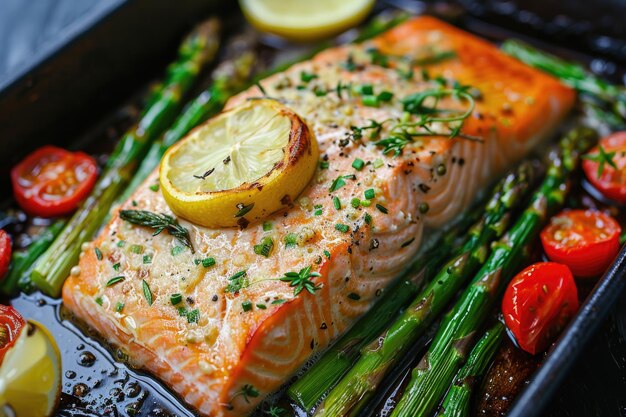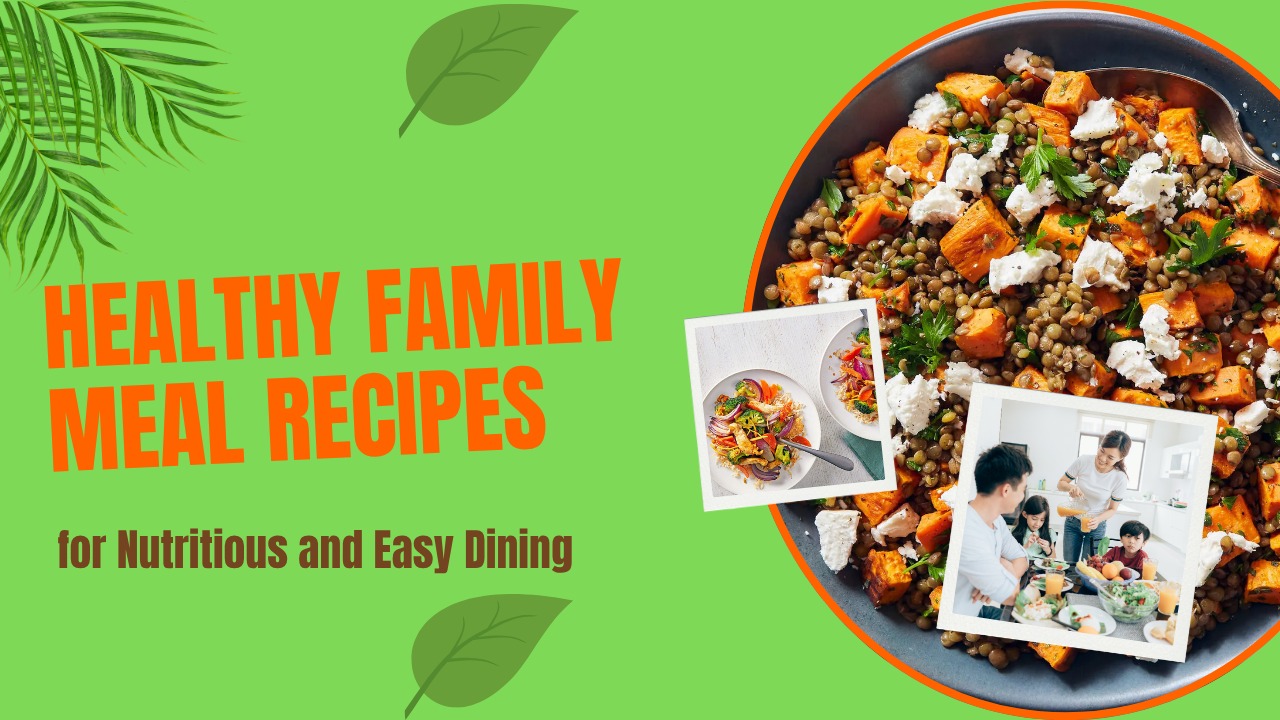Feeding your family healthy meals every day can often feel overwhelming. With hectic schedules, picky eaters, and the need to balance nutrition with taste, it’s understandable that meal time can become stressful. However, with a bit of planning and the right approach, it doesn’t have to be this way.
One key to making healthy meals easier is having a collection of simple, nutritious recipes ready to go. Whether it’s a quick stir-fry or a hearty vegetable soup, having go-to “healthy family meal recipes” can help streamline the process and ensure that everyone is satisfied with the food.
Additionally, making small adjustments to familiar dishes, like swapping in whole grains or adding extra vegetables, can boost the nutrition without sacrificing flavor. With some creativity and a little advance preparation, you can create healthy meals that not only taste great but are also beneficial for the whole family’s health.
In this article, we’ll explore why healthy meals are crucial for families, offer practical tips for meal planning, and share a variety of delicious and balanced family-friendly recipes that focus on whole foods, vibrant flavors, and nutritional balance.
Why Are Healthy Family Meals Important ?

Building Strong Foundations for Health
The meals your family consumes play a crucial role in not only fueling their bodies but also in laying the groundwork for their long-term health. A balanced diet that includes a variety of vegetables, fruits, whole grains, lean proteins, and healthy fats is essential in supporting growth, strengthening the immune system, and preventing the onset of chronic diseases. By developing healthy eating habits early in life, you are helping to reduce the likelihood of obesity, diabetes, heart disease, and other health problems later on. The foods you choose today will have a lasting impact on your family’s overall well-being.
Emotional and Social Benefits of Shared Meals
Mealtime isn’t just about nourishment; it’s also an important opportunity for emotional connection and social bonding. Eating together as a family fosters stronger relationships, encourages better communication, and promotes a sense of togetherness. Research has shown that children who regularly share meals with their families are less likely to engage in risky behaviors and tend to perform better academically. The emotional benefits of shared meals go far beyond the physical nutrients they provide—they create lasting memories and positive emotional connections that shape family dynamics.
Overcoming Challenges
Despite the clear benefits of family meals, modern-day challenges such as tight schedules, limited cooking skills, and differing taste preferences can make healthy eating seem like an impossible task. However, with the right tools, overcoming these challenges is entirely achievable. This article will provide you with practical strategies and a variety of “healthy family meal recipes” that fit seamlessly into your busy lifestyle, ensuring that you can serve meals that are both nutritious and enjoyable for even the pickiest eaters.
Tips for Creating Healthy Family Meals
Plan Ahead
Effective meal planning is one of the most beneficial habits you can adopt for a healthier family lifestyle. By dedicating just 30 minutes each week to plan your meals, create a detailed grocery list, and prep ingredients in advance, you can significantly reduce mealtime stress. Not only will this practice save you money, but it also minimizes the temptation to make unhealthy last-minute choices, ensuring that you stay on track with your nutritional goals. By preparing in advance, you can ensure that the meals you serve are both nutritious and balanced, contributing to your family’s overall well-being.
Involve Everyone
Getting the whole family involved in meal planning, grocery shopping, and cooking is a fantastic way to create a collaborative and educational experience. When children participate in the cooking process, they are more likely to take an interest in the meals and eat what they’ve helped prepare. This is also an excellent opportunity to teach them valuable lessons about nutrition, healthy eating, and the importance of wholesome ingredients. By making these activities a family event, you not only promote bonding but also help instill lifelong healthy eating habits.
Focus on Whole Foods
A key principle for preparing nutritious meals is to focus on whole foods. Base your meals around fresh vegetables, fruits, lean proteins, whole grains, nuts, and seeds. These natural ingredients are packed with essential nutrients and are far less processed than their packaged counterparts, making them a superior choice for both nutrition and overall health. By incorporating whole foods into your meals, you can significantly boost your family’s intake of vitamins, minerals, and fiber, ensuring that they get the best possible nutrition with every meal.
Balance Your Plate
Creating a balanced plate is a simple yet effective way to ensure that you are providing your family with well-rounded meals. Aim for a colorful plate that includes half of your plate filled with vegetables, a quarter with lean protein, and the other quarter with whole grains. A small portion of healthy fats, such as olive oil, avocado, or nuts, should also be included. This visual method of portioning helps you achieve a variety of nutrients at each meal and ensures your family is getting a good mix of protein, fiber, and essential vitamins.
Cook Once, Eat Twice
Batch cooking and meal prepping are time-saving strategies that can make a significant difference in your week. By preparing larger portions of your healthy family meal recipes, you can save leftovers for lunch or another dinner, reducing the time and effort spent on cooking every day. This approach also makes it easier to stick to healthy eating habits, as you’ll always have nutritious meals ready to go, even on busy days when you don’t have time to cook.
Make It Fun and Flavorful
To keep meals exciting and enjoyable for the whole family, incorporate a variety of herbs, spices, and different cooking techniques. This not only enhances the flavor but also introduces new tastes and textures to your meals, making them more appealing. Encourage your family to try new foods by presenting them in fun and creative ways, such as making colorful veggie wraps or using fun-shaped cookie cutters for fruits and vegetables. Keeping mealtime fun and flavorful helps foster a positive relationship with food and can make healthy eating an enjoyable experience for everyone.
Healthy Family Meal Recipes to Try
Here are a variety of recipes suitable for breakfast, lunch, dinner, and snacks. These dishes are easy to prepare, nutritious, and designed to appeal to family members of all ages.
Breakfast Recipes
Veggie-Packed Breakfast Scramble

A Veggie-Packed Breakfast Scramble is a nutritious and easy way to start the day. This dish is loaded with colorful vegetables like spinach, bell peppers, onions, and tomatoes, providing a variety of vitamins and minerals that fuel the body. The scramble is made with eggs, offering a healthy source of protein to keep you full and energized throughout the morning.
This breakfast can be easily customized to suit your family’s preferences. You can add mushrooms, zucchini, or even a sprinkle of cheese for extra flavor. It’s a great way to sneak in more veggies, especially for picky eaters who may not enjoy vegetables on their own.
Not only is this Veggie-Packed Breakfast Scramble a delicious option, but it also fits perfectly into your collection of “healthy family meal recipes.” It’s quick to prepare, making it an ideal choice for busy mornings when you still want a wholesome and satisfying meal.
Ingredients:
6 eggs or egg whites
1 cup spinach, chopped
1/2 cup cherry tomatoes, halved
1/4 cup bell peppers, diced
1 small onion, diced
1 tbsp olive oil
Salt and pepper to taste
Instructions:
Heat olive oil in a skillet over medium heat.
Add onions and bell peppers; sauté until soft.
Add spinach and tomatoes; cook until wilted.
Whisk eggs and pour over vegetables; scramble until cooked.
Season with salt and pepper and serve with whole grain toast.
Why it’s healthy: Packed with protein and fiber-rich veggies, this meal boosts energy and keeps kids full until lunch.
Overnight Oats with Berries and Nuts
Overnight oats with berries and nuts is a simple, yet delicious breakfast that packs a punch of nutrition. By mixing oats with milk or a dairy-free alternative and letting it sit overnight, you create a creamy, ready-to-eat base that’s both convenient and healthy. The oats provide a great source of fiber, while the milk adds protein and essential nutrients.
Topping the oats with fresh berries like strawberries, blueberries, or raspberries adds a burst of antioxidants, vitamins, and natural sweetness. Nuts like almonds or walnuts offer a satisfying crunch and healthy fats, which help keep you feeling full longer.
This dish is not only easy to prepare but also fits perfectly into your collection of “healthy family meal recipes.” It’s a quick, nutritious, and customizable breakfast option that can be prepped ahead of time, making busy mornings a breeze while providing your family with essential nutrients.
Ingredients:
1/2 cup rolled oats
1/2 cup unsweetened almond milk or milk of choice
1/2 cup Greek yogurt
1 tbsp chia seeds
1/2 cup mixed berries (blueberries, strawberries)
1 tbsp chopped walnuts or almonds
1 tsp honey or maple syrup (optional)
Instructions:
In a jar or bowl, combine oats, milk, yogurt, and chia seeds.
Stir well and refrigerate overnight.
In the morning, top with berries, nuts, and a drizzle of honey.
Why it’s healthy: Rich in fiber, antioxidants, and protein, this make-ahead breakfast is quick and customizable.
Lunch Recipes
Quinoa and Chickpea Salad

Quinoa and chickpea salad is a vibrant, nutrient-packed dish that makes for an excellent lunch or side. Quinoa is a complete protein, meaning it contains all nine essential amino acids, making it a great base for a plant-based meal. The addition of chickpeas provides extra fiber and protein, promoting fullness and sustained energy.
This salad can be customized with a variety of vegetables, such as cucumbers, bell peppers, and cherry tomatoes, which add crunch and freshness. A simple dressing of olive oil, lemon juice, and herbs brings the flavors together, making it a zesty and satisfying dish.
Perfect for meal prepping, this quinoa and chickpea salad fits seamlessly into your collection of “healthy family meal recipes.” It’s easy to prepare in advance, can be enjoyed chilled, and is packed with wholesome ingredients that support your family’s health while tasting great.
Ingredients:
1 cup cooked quinoa
1 cup cooked chickpeas (canned, rinsed)
1 cucumber, diced
1 red bell pepper, diced
1/4 cup red onion, finely chopped
1/4 cup fresh parsley, chopped
Juice of 1 lemon
2 tbsp olive oil
Salt and pepper to taste
Instructions:
Combine quinoa, chickpeas, cucumber, bell pepper, onion, and parsley in a bowl.
Whisk lemon juice and olive oil; pour over salad.
Toss to coat and season with salt and pepper.
Why it’s healthy: This vegetarian dish is a complete protein and loaded with fiber and vitamins.
Turkey and Avocado Wrap
A Turkey and Avocado Wrap is a quick, delicious, and healthy meal perfect for lunch or dinner. Lean turkey provides a great source of protein, while creamy avocado adds healthy fats that support heart health. This combination creates a satisfying meal that keeps you full and energized.
You can add a variety of fresh vegetables like lettuce, tomatoes, or cucumbers for extra crunch and flavor. A light spread of mustard or hummus can also enhance the taste without adding too many extra calories.
This Turkey and Avocado Wrap is not only tasty but also fits well into your collection of “healthy family meal recipes.” It’s easy to make, customizable for picky eaters, and can be prepared quickly, making it an ideal choice for busy days when you need a wholesome meal. Plus, it’s perfect for meal prep and on-the-go lunches.

Ingredients:
Whole grain wraps or tortillas
Sliced turkey breast (lean, no added nitrates)
1 avocado, sliced
Lettuce or spinach leaves
Tomato slices
Mustard or hummus spread
Instructions:
Spread mustard or hummus on the wrap.
Layer turkey, avocado, lettuce, and tomato.
Roll tightly and slice in half.
Why it’s healthy: Provides lean protein and healthy fats, with plenty of fresh veggies.
Dinner Recipes
Baked Lemon Herb Salmon with Roasted Vegetables
Baked Lemon Herb Salmon with Roasted Vegetables is a flavorful and nutritious dinner option that’s both simple and satisfying. The salmon is seasoned with lemon, garlic, and herbs, creating a light yet savory taste. Packed with omega-3 fatty acids, salmon supports heart health and provides high-quality protein.
Alongside the salmon, roasted vegetables such as carrots, zucchini, and sweet potatoes are tossed in olive oil and seasoned to perfection. Roasting the vegetables enhances their natural sweetness while retaining key nutrients, making them a healthy side dish.

This dish is not only delicious but also fits perfectly into your collection of “healthy family meal recipes.” It’s easy to prepare and requires minimal hands-on time, making it ideal for busy evenings. The combination of healthy fats, protein, and fiber ensures your family enjoys a well-rounded and satisfying meal.
Ingredients:
4 salmon fillets
1 lemon, thinly sliced
2 tbsp olive oil
1 tsp dried oregano
1 tsp garlic powder
Salt and pepper to taste
Mixed vegetables (broccoli, carrots, zucchini), chopped
Instructions:
Preheat oven to 400°F (200°C).
Place salmon on a baking sheet lined with parchment paper.
Drizzle olive oil over salmon and vegetables.
Sprinkle oregano, garlic powder, salt, and pepper.
Top salmon with lemon slices.
Roast for 15-20 minutes until salmon is cooked and vegetables are tender.
Why it’s healthy: Salmon provides omega-3 fatty acids vital for brain and heart health; roasted veggies add fiber and antioxidants.
Chicken and Vegetable Stir-Fry
Chicken and Vegetable Stir-Fry is a quick and nutritious meal that’s perfect for busy weeknights. Lean chicken breast provides a great source of protein, while a colorful mix of vegetables like bell peppers, broccoli, and carrots adds essential vitamins and fiber. This combination makes for a balanced meal that supports overall health.
The stir-fry is cooked in a light sauce made from soy sauce, garlic, and ginger, bringing a burst of flavor without excess calories. The vegetables retain their crunch and nutrients, making each bite both delicious and satisfying.
This Chicken and Vegetable Stir-Fry is a fantastic addition to your collection of “healthy family meal recipes.” It’s easy to prepare, customizable to your family’s preferences, and can be served with brown rice or quinoa for an extra boost of fiber. It’s a wholesome meal that your whole family will enjoy in just minutes.
Ingredients:
2 chicken breasts, sliced thinly
1 cup broccoli florets
1 red bell pepper, sliced
1 carrot, julienned
2 cloves garlic, minced
1 tbsp fresh ginger, grated
2 tbsp low-sodium soy sauce or tamari
1 tbsp olive or sesame oil
Cooked brown rice, to serve
Instructions:
Heat oil in a wok or large skillet.
Add garlic and ginger, sauté for 30 seconds.
Add chicken slices and cook until browned.
Add vegetables and stir-fry until tender-crisp.
Pour soy sauce over and mix well.
Serve over brown rice.
Why it’s healthy: Lean protein combined with colorful veggies and whole grains makes this meal balanced and satisfying.
Snack Recipes
Homemade Hummus with Veggie Sticks

Homemade Hummus with Veggie Sticks is a simple and healthy snack that everyone in the family can enjoy. The hummus, made from blended chickpeas, tahini, olive oil, and lemon juice, is a creamy, protein-packed dip that provides essential nutrients like fiber, healthy fats, and vitamins. It’s a great option for a light meal or snack.
Pairing the hummus with fresh veggie sticks like carrots, cucumber, and bell peppers not only adds crunch but also boosts the fiber and vitamin content. The variety of colors and textures makes it an appealing choice, especially for picky eaters.
This Homemade Hummus with Veggie Sticks is a fantastic addition to your “healthy family meal recipes.” It’s quick to prepare, versatile, and perfect for meal prepping. Whether as an afternoon snack or a side dish, it’s a wholesome option that’s both nutritious and enjoyable for everyone.
Ingredients:
1 can chickpeas, drained and rinsed
2 tbsp tahini
1 clove garlic
Juice of 1 lemon
2 tbsp olive oil
Salt and pepper to taste
Carrot sticks, cucumber slices, bell pepper strips
Instructions:
In a food processor, blend chickpeas, tahini, garlic, lemon juice, and olive oil until smooth.
Season with salt and pepper.
Serve with fresh vegetable sticks.
Why it’s healthy: High in fiber and protein, hummus is a nutrient-dense dip that encourages eating more veggies.
Greek Yogurt with Honey and Nuts

Greek Yogurt with Honey and Nuts is a simple, yet delicious, snack or breakfast option that offers both flavor and nutrition. Greek yogurt is rich in protein and probiotics, which support digestion and muscle health. The addition of honey provides a natural sweetness, while also offering antioxidants and antibacterial properties.
Topping the yogurt with a handful of nuts, such as almonds or walnuts, adds healthy fats and a satisfying crunch. Nuts also provide important nutrients like omega-3 fatty acids, vitamins, and minerals that contribute to heart and brain health.
This Greek Yogurt with Honey and Nuts is a perfect addition to your collection of “healthy family meal recipes.” It’s easy to prepare, customizable with different fruits or seeds, and provides a balanced combination of protein, healthy fats, and natural sweetness. It’s an ideal option for a quick breakfast, snack, or even dessert.
Ingredients:
1 cup plain Greek yogurt
1 tsp honey
1 tbsp chopped nuts (walnuts, almonds)
Instructions:
Spoon yogurt into a bowl.
Drizzle with honey and sprinkle with nuts.
Why it’s healthy: This snack provides probiotics, protein, and healthy fats to keep energy levels steady.
Creating Lasting Healthy Habits
Making healthy family meals a consistent part of your routine is less about perfection and more about progress. Here are some final thoughts on building sustainable habits:

Be Patient: Introduce new foods to your family gradually and give them time to adjust. Repeated exposure can help them become more open to trying different dishes.
Celebrate Small Wins: Celebrate when your children try new foods or assist in the kitchen. Positive reinforcement encourages them to continue exploring healthy options and engaging with food in a fun way.
Limit Processed Foods: Focus on using fresh, natural ingredients and homemade meals. Avoid processed foods as much as possible to ensure your family enjoys more nutritious, wholesome meals.
Stay Flexible: It’s important to have a balanced approach to eating. While healthy meals are essential, occasional treats are perfectly fine. Moderation is key for overall well-being.
Model BehavioUr: Be a role model by showing excitement and enthusiasm for healthy foods. Your positive attitude towards eating nutritious meals can inspire your children to adopt similar habits. Incorporating these strategies into your routine can help create lasting habits with your “healthy family meal recipes.”
Conclusion
Creating healthy family meal recipes doesn’t have to be overwhelming. With thoughtful planning and simple, nutritious ingredients, you can prepare meals that are both delicious and beneficial for everyone’s well-being. These recipes prove that healthy eating can be enjoyable and easy to incorporate into your family’s daily routine.
By involving your loved ones in meal preparation and focusing on whole foods, you foster better eating habits and strengthen family bonds. The variety of recipes shared—from hearty breakfasts to satisfying dinners and wholesome snacks—offers options that suit diverse tastes and busy schedules, making nutritious eating accessible for all.
Ultimately, embracing healthy family meal recipes is a powerful way to invest in your family’s long-term health while creating meaningful moments around the dinner table. Small changes today can lead to a lifetime of wellness, happiness, and connection for you and your loved ones.
FAQs
What are some easy “healthy family meal recipes” for busy weeknights ?
Simple meals like stir-fries, salads, and one-pan dishes are great options. Quinoa bowls, baked salmon, and veggie-packed scrambles are easy to prepare and perfect for busy nights.
How can I get my picky eater to try new foods ?
Introduce new foods gradually, and make the experience fun. Allow them to help in the kitchen and praise them when they try something new, even if it’s just a small bite.
How can I ensure my family is eating balanced meals ?
Aim for a variety of food groups in each meal—half your plate should be vegetables, a quarter protein, and a quarter whole grains. Healthy fats should also be included in moderation.
Can I prepare healthy meals in advance for the week ?
Yes! Meal prepping is a great way to save time. Prepare large batches of healthy family meal recipes like salads, casseroles, or roasted vegetables that can be easily reheated throughout the week.
Are there healthy alternatives to processed snacks ?
Yes, you can swap processed snacks for fresh fruits, veggies with hummus, nuts, or homemade granola bars. These options are nutritious and provide better energy.


